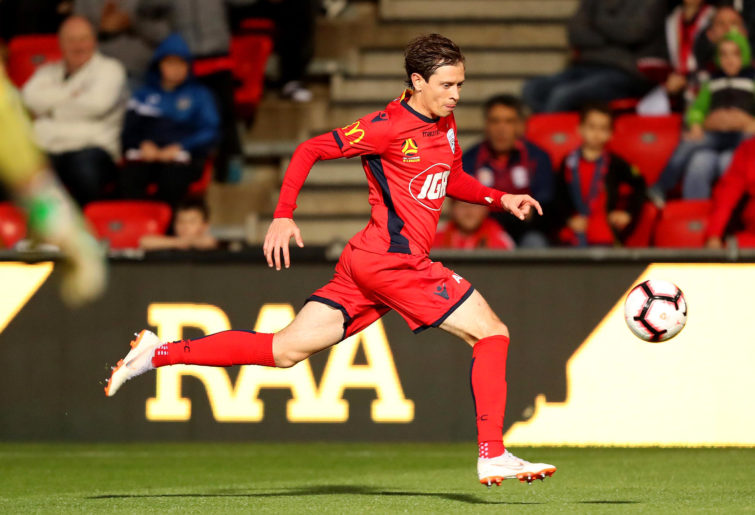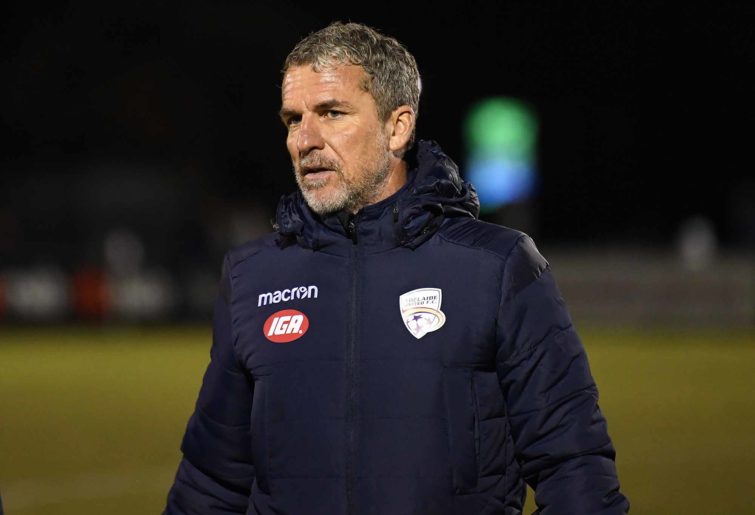In Friday’s incendiary clash between Adelaide and Brisbane, beneath the crimson flashes of fury and the sickening slips into violence, there was an interesting tactical discussion being staged, with the two teams testing different answers to a similar question.
The Reds and the Roar both set up without a primary play-maker occupying that classic No.10 position. First, to Adelaide.
In fielding a midfield of Isaias and Vince Lia, Marco Kurz pairs a combative ball-winner with a deep-lying play-maker. The rotations these two players cycle through involve the Spaniard dropping all the way back to his centre-backs and collecting the ball with Lia rumbling forward and back, winning tackles and passing simply.
When Isaias does push up and make direct vertical passes in the attacking half, he is most often playing passes out to the flanks, to his flying wingers Ryan Kitto and Craig Goodwin.
Ken Ilso roams out to the flanks, and drops sporadically back into that No.10 spot, but not for long enough to really consider him a telling presence there, only enough to dissuade teammates to join him in the zone. Ben Halloran is an entirely non-traditional winger-cum-striker, and flits all over the park; there is, as a result, a distinct lack of a central probing presence, and Adelaide don’t seem to seek extended periods of possession in the advanced central midfield.
Ilso and Halloran – whose average positions in this game ended up practically shoulder to shoulder – spend the most time in that No.10 zone, but are engaged in a constant interchange of positions.
This is not a bad thing, necessarily, and in Adelaide’s case, specifically. The actions that garnished a lot of Adelaide’s 2-1 in bypassed the central corridor entirely, with Goodwin four times responsible for hitting wonderful raking passes from the left to the right wing.
Taylor Regan then had a go too, but his wasn’t quite as accurate.
Adelaide’s strengths are the pace of their wingers, the accurate crossing and the combination passing strung together at speed. Their opening goal was a product of one of those long diagonals hit by Jordan Elsey up towards Goodwin. Isaias, who was cycling back to the defence before the long ball was hit, had charged up to collect the defensive header, a poor clearance.
Isaias then threaded through Goodwin, who crossed for Halloran.
The flint and fuel for this move was the long pass and the winger’s run; once those two factors combined, the situation ignited, and the goal was forged. There was no need to involve anyone in the advanced central midfield.

(Photo by James Elsby/Getty Images)
Brisbane also seem to be content not to play with a dedicated advanced central play-maker. Of the three central midfielders, against Adelaide it was Matt McKay who was the most advanced position-wise, and yet he had only 21 touches, fewer than a third of the total both his midfield colleagues managed.
McKay appears to be busied most principally with leading the high press, shuffling sideways, patrolling and sniffing out passing routes to block. A defensive forward, should such a thing exist.
Kristensen mops up and resets broken possessions, offers passing outlets to attackers who have run into cul de sacs, and occasionally trots up the pitch off the ball. Lopez is the most involved and offensively interested of the three; he leads the team in goal-involvements and through-balls played this season, but has to embark on missions up-field from a fairly deep position. Compare Lopez’s touch map in the loss to Adelaide to Western Sydney’s Alexander Baumjohann’s – an archetypal No.10 – in the German’s game last week against the Jets: only eight of Baumjohann’s 69 touches were made inside his own half, and the rest were evenly spread across the pitch, working as he does from a held central position.
Lopez, on the other hand, took 29 of his 74 touches in his own half, and his involvements lean slightly towards the left of the pitch; through pure tyranny of occupancy, he cannot demand the central areas to himself.
Eric Bautheac – playing as an inverted winger, left-footed but on the right wing – was probably the Roar’s most prominent attacker against Adelaide, certainly in the first half, and the way he seems designed to collect the ball and cut inside also means having a traditional No.10 would in effect be an unnecessary doubling of work.
Mikkelsen is also an inverted winger, right-footed on the left wing, also tasked with cutting in and play-making or shooting; indeed, the Dane narrowly missed a cut-and-shut on goal in the first half against Adelaide just before halftime.
These two teams are, in different ways, compensating for not having a central play-maker or, to put it another way, John Aloisi and Marco Kurz are trying to find the most elegant way of including a raft of versatile, non-specialised attackers for whom there is no set function.

(AAP Image/Julian Smith)
For the Reds, a liberal sharing of duties also occurs, with all three of Isaias, Halloran, and Ilso taking turns in the play-making role, making sure than the latter two players also rotate in and out of the striker’s position too. Adelaide’s second goal saw these rotations occur over the course of a few seconds of play; you can see here, as Goodwin squirms out of trouble on the wing, Halloran is placed ahead of him, right out on the touchline, and Ilso – off-screen for most of the build up, save for a glimpse of him rushing back onside – has assumed the central striker’s position, ready to spring off the shoulder of his defender.
Here, too, Isaias shunts up a little, playing a through ball that doesn’t quite come off, a brief morphing into the more advanced play-maker. Then, Ilso drops back to join the play in the midfield, and as he and Kitto combine on the right, Halloran duly drifts into the centre to offer the striking option, eventually taking up a classic poacher’s position that allows him to prey gleefully on a rebound tap-in.
In these sequences, it all seems logical that players should step in and out of these roles, but it’s only thanks to the fluidity of Adelaide’s system that this logic is so expressed.
For Brisbane, Aloisi has made a decision to play McKay in the middle, with Lopez and Kristensen deeper-placed, and has made up for any dearth of creativity this causes by inverting his wingers, encouraging them to step inwards and combine with teammates, or shoot. Mikkelsen’s average position in this game was inside the central corridor, and his touches were dotted across the full width of the pitch, switching flanks, cutting inside, drifting with intent.
Of the two teams, Adelaide’s system is working more coherently, and certainly with Adam Taggart’s injury, Brisbane’s potency will be diminished severely. But both managers should be given credit for their inventiveness; although it’s a sweet luxury to be able to field a high-spec No.10, and build around him, it isn’t the only way of arranging a functional attack.
Adelaide and Brisbane are showing that there are different, perhaps more democratic ways of utilising that advanced midfield zone.






























































































